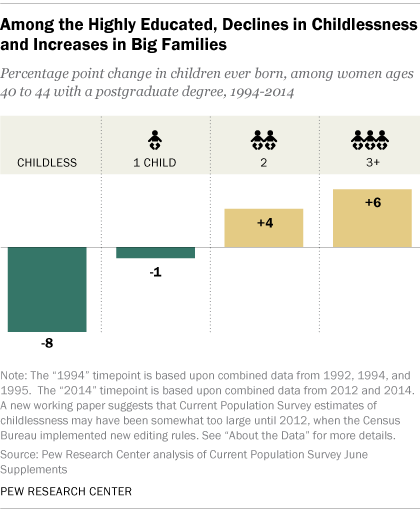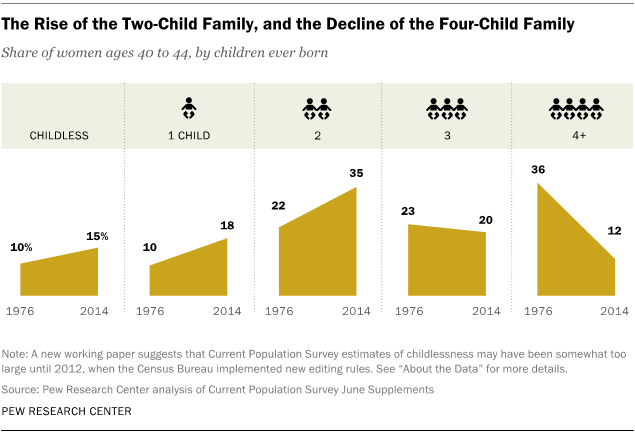What Is the Correlation Between Women's Education and Family Size
 Among women in the U.s.a., postgraduate education and maternity are increasingly going hand-in-hand. The share of highly educated women who are remaining childless into their mid-40s has fallen significantly over the past two decades.i
Among women in the U.s.a., postgraduate education and maternity are increasingly going hand-in-hand. The share of highly educated women who are remaining childless into their mid-40s has fallen significantly over the past two decades.i
Today, about one-in-five women ages xl to 44 with a chief's degree or college (22%) take no children – downward from 30% in 1994, according to a Pew Enquiry Center analysis of newly released Demography Bureau data. The turn down is particularly dramatic among women with an Thousand.D. or Ph.D. – fully 35% were childless in 1994, while today the share stands at 20%. Non but are highly educated women more likely to have children these days, they are also having bigger families than in the past. Amid women with at least a master'due south degree, six-in-10 have had 2 or more than children, up from 51% in 1994. The share with two children has risen 4 percentage points, while the share with iii or more has risen half dozen percentage points.2
This trend has likely been driven past demographic and societal changes. Information technology coincides with women's growing presence in managerial and leadership positions and suggests that an increasing share of professional person women are against the inevitable push button and pull of work-family unit balance. Previous Pew Research analysis has plant that overall women devote fewer hours to paid work with each additional child they take. On average, a working-age woman with no children spends 27 hours per week in paid piece of work, while a woman with three or more than children spends 18 hours working. In addition, working mothers are more 3 times every bit probable as working fathers to say that being a working parent has made information technology more than difficult for them to advance in their career (51% vs. 16%).
Fueled in part past the increases in maternity amid highly educated women, childlessness amongst all women ages 40 to 44 in the U.S. is at its lowest betoken in a decade.3 In 1994, 18% of all women at the finish of their childbearing years had not borne a child. That number rose to 20% past the mid-2000s earlier declining to fifteen% in 2014. At the same fourth dimension, the boilerplate number of children that U.Southward. women have in their lifetime has remained quite stable over the past 20 years, at about two children.
The fact that completed family size has changed petty since the mid-1990s may seem counterintuitive, given the amount of attention often directed toward the so-called "Baby Bust" in the postal service-recession U.S. Information technology is true that analyses based on changes in annual fertility rates have shown consistent declines in childbearing since 2007, suggesting that fertility is at an all-time low. Nevertheless, these analyses are capturing fertility at i point in time, as opposed to the cumulative measure out of lifetime fertility used in this assay. Function of what accounts for the low fertility indicated by annual rates is the fact that many women are putting off having children until later in life, both due to broad cultural changes (such as increasing instruction), and due to the Bully Recession, which intensified delayed childbearing, particularly among younger women. What remains to be seen is whether these declines in annual birth rates volition continue, and will translate into lower lifetime fertility for women at the end of their childbearing years. Some experts doubtable that, equally with past economic downturns, women may ultimately "take hold of upwards" on their fertility, though i recent analysis suggests that fertility delayed due to the Great Recession may in fact exist fertility foregone.

Regardless of short-term fertility patterns and their implications, there is no denying that the longer-term trend has been toward much smaller American families. Looking back to 1976, the beginning year for which information are bachelor, the boilerplate adult female in her early 40s in the U.South. had given birth to three children, and 36% of women in this age range had four or more children. By 2014, the big family sizes that prevailed in the 1970s had been fully supplanted by the two-kid family. At present 35% of all women ages 40 to 44 accept ii children, while just 12% have four or more. At the same time, one-child families have gained ground – today eighteen% of women at the finish of their childbearing years have an but child, upward from 10% in 1976. Near 20% of women take three children, a number that has remained virtually unchanged.
These findings are based on a Pew Enquiry Eye analysis of noncombatant women almost the end of their childbearing years, using data from the 1976-2014 June Supplements of the Current Population Survey. The June Supplement is typically conducted every other yr, and produces a nationally representative sample of the non-institutionalized population of the U.S. While the overview and outset section of this written report analyzes childlessness and fertility amongst all women, the final section examines mothers only, focusing on trends and variations in the number of children that they have had in their lifetimes.
Other key findings:
- While fertility trends among highly educated women show a clear design of less childlessness and bigger families, the trends among less-educated women are not as clear-cutting. Childlessness is down among women lacking a high school diploma and among women with a available'southward caste, but otherwise family size for these two groups has changed fiddling since 1994. And among loftier school graduates, the share of women ages xl to 44 with one child has increased, but at that place has been no change in the share with bigger families.
- The educational "gaps" in childlessness and in family unit size have narrowed in the past 2 decades, but they do persist. The more than pedagogy a woman has, upwards to a available'due south caste, the less likely she is to become a mother. And among mothers, those with more teaching accept fewer children than those with less education. For case, just 13% of moms lacking a high school diploma take ane child, while fully 26% accept four or more, while among mothers with a main's degree or more, 23% accept only children and only 8% take four or more.
- Fertility patterns differ significantly past race and ethnicity. Some 17% of white women ages 40 to 44 are childless, compared with xv% of blackness women in the aforementioned age group, 13% of Asian women and just 10% of Hispanic women.
- Hispanic and black mothers ages 40 to 44 are especially likely to take large families. Fully 20% of Hispanic moms have iv or more children, as practise 18% of black moms. In comparison, merely 11% of white mothers accept 4 or more children, as do ten% of Asian mothers. Since 1988, in that location has been a dramatic decline in the share of mothers with iv or more children amidst Hispanics, blacks and whites.
Most the Data
Findings in this written report are based on information from the U.S. Census Bureau's June Supplement of the Current Population Survey (CPS). The June Fertility Supplement was kickoff administered in 1976 and is typically conducted every other year. Public-use data files prior to 1986 are not readily bachelor, and so analyses of pre-1986 timepoints are drawn from census tabulations.
Given the nature of the CPS data, a "mother" is here divers as any woman who has given birth to a kid, while those who have not given nativity are counted as "childless." However, many women who do not comport their own children are indeed mothers. Estimates propose that 7% of children living with a parent householder in the U.S. are living with either an adoptive parent or a stepparent.
This report defines the end of the childbearing years equally ages 40 to 44, which has typically been the convention, partly due to the fact that few women have babies beyond these ages, and partly due to the fact that, until recently, data on the completed fertility of women ages 45 and older were not collected. While engineering is extending the age at which women can have children, the vast majority even so take children before age 45. In 2013, about 0.2% of births occurred to women ages 45 or older, and analyses from the Census Bureau show that childlessness among women ages forty to l is similar to childlessness among women ages 40 to 44.
Analyses looking at all women, or at all mothers, are based upon data from single years. For the detailed analyses of educational, racial and ethnic differences in fertility, which are the primal focus of this report, multiple years of data are combined in lodge to create sufficient sample sizes. The information from 2012 and 2014 are combined, and referred to every bit "2014"; data from 1992, 1994, and 1995 are combined, and referred to as "1994"; and data from 1986, 1988, and 1990 are combined and referred to as "1988".
A new working paper suggests that prior to 2012, when new editing protocols were implemented past the Census Bureau, the Electric current Population Survey may have overestimated childlessness somewhat. This makes it difficult to determine the exact magnitude of changes in childlessness across time, though simulations propose that childlessness is lower now than it was in 2004 and 2006, and no higher than it was around 1994, even taking the new editing protocol into business relationship.
In 1992, the Census Bureau introduced a new variable with detailed categories of educational attainment assuasive for definitive identification of individuals by whether they have a bachelor's caste, a master'due south caste, a Ph.D. or an M.D. Prior to that yr, analyses of such detailed educational breaks was not possible. As such, the assay of fertility by educational attainment begins with the 1992 information.
Data regarding racial and ethnic groups is available every bit early as 1986, but the sample sizes for Asian women ages xl to 44 is so small-scale that even combining multiple years does not produce an adequate sample size. As such, the fertility of Asian women could not exist reliably estimated for the 1988 timepoint used in the report.
A Note on Terminology
References to respondents who are high schoolhouse graduates or who accept a high school diploma also include those who take earned an equivalent degree, such as a GED (General Educational Development) certificate.
References to respondents with "some college" include those who have a ii-year caste.
References to respondents with "postgraduate" degrees include all people who have at least a master's caste.
All references to whites, blacks and Asians are to the non-Hispanic components of those populations. Asians too include Pacific Islanders. Hispanics are of any race.
Source: https://www.pewresearch.org/social-trends/2015/05/07/childlessness-falls-family-size-grows-among-highly-educated-women/
0 Response to "What Is the Correlation Between Women's Education and Family Size"
Postar um comentário